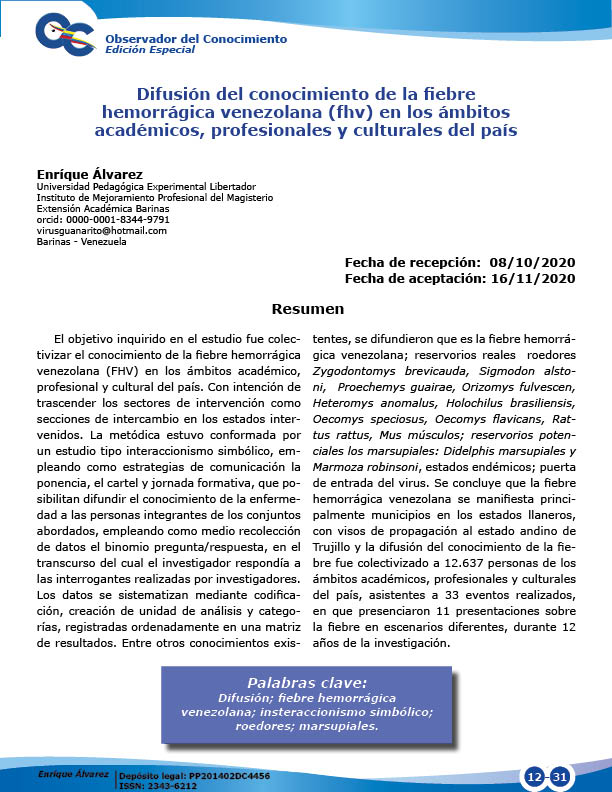Dissemination of knowledge of venezuelan hemorrhagic fever (la hemorrágica) in the academic, professional and cultural fields of the country
Keywords:
Diffusion ; venezuelan hemorrhagic Fever ; symbolic interactionism ; rodents ; marsupialsAbstract
The objective investigated in the study was to collectivize the knowledge of Venezuelan hemorrhagic fever (VHF) in the academic, professional and cultural fields of the country. With the intention of transcending the intervention sectors as exchange sections in the intervened states. The method was made up of a symbolic interactionism-type study, using as communication strategies the presentation, the poster and the training session, which make it possible to disseminate knowledge of the disease to the people who are members of the groups addressed, using the binomial as a means of data collection question / answer, in the course of which the researcher answered the questions asked by the researcher. The data is systematized by means of coding, creation of unit of analysis and categories, registered in an orderly manner in a results matrix. Among other existing knowledge, they spread that it is Venezuelan hemorrhagic fever; rodent royal reservoirs Zygodontomys brevicauda, Sigmodon alstoni, Proechemys guairae, Orizomys fulvescen, Heteromys anomalus, Holochilus brasiliensis, Oecomys speciosus, Oecomys flavicans, Rattus rattus, Mus musculos; marsupials potential reservoirs: Didelphis marsupialis and Marmoza robinsoni, endemic states; gateway of the virus. It is concluded that Venezuelan hemorrhagic fever manifests itself mainly in municipalities in the plains states, with signs of spreading to the Andean state of Trujillo and the dissemination of knowledge of the fever was collectivized to 12,637 people from the academic, professional and cultural fields of the country, assistants to 33 events held, in which they witnessed 11 presentations on fever in different settings, during 12 years of research.
Downloads
References
BELANDRIA ABAD, A. A. (2008). Estudio de una comunidad de pequeños mamíferos no voladores, amenazada de extinción en una zona agrícola del sur del Lago de Maracaibo. En Diego Giraldo, Franklin Rojas Suarez y Víctor Romero (Eds.). Una Mano a la Naturaleza. Conservando las Especies Amenazadas Venezolanas. PROVITA. [Libro Electrónico en Línea].
Recuperado en: http://www.provita.org. ve/resources/dowloads/UnaManoalaManoalaNaturaleza.pdf.
BOADA C. (2014). Didelphis marsupialis. En Santiago F. Burneo (ed.). Mamíferos
del Ecuador. Quito, Ecuador. Recuperado el 3 de octubre de 2015 en:
http://www.scielo.org.co/pdf/bio/v26n1/v26n1a06.pdf.Versión 2015.0. Museo de Zoología, Pontifica Universidad Católica del Ecuador. Quito. Ecuador.
GARCÍA, F. J.; DELGADO, M. ; MACHADO, M.; AULAR, L. y MUJICA, Y. (2013). Pequeños mamíferos no voladores de un bosque nublado del Parque Nacional Yurubí, Venezuela: Abundancias relativas y estructura poblacional. Recuperado el 7 de septiembre de 2015 en: http://www/redalic.org/pdf/339/33929482005.pdf.
GUTIÉRREZ, E., E., ANDERSON, R. P., VOSS, R., S. OCHOA-G., J.; AGUILERA, M., JANSA, SHARON, A. (2014). Phylogeography of Marmosa robinsoni: insights into the biogeography of dry forests in northern South America. Recuperado el 7 de octubre de 2016 en:
jmammal.oxfordjournals. org/ content/ 95/6/1175
JORNASTEC (2010). Guía de Referencia para la Elaboración de Carteles o Póster
Científicos JORNASTEC 2010.Recuperado en enero de 2016 en: http://www.
jornatec.org.ve/2010/doc/guia_cartel_cientifico_jornatec. pdf
LINARES, J. y RIVAS, B. (2004). Mamíferos del Sistema Deltaico (Delta del Orinoco-Golfo de Paria), Venezuela. Recuperado en septiembre de 2015 en:
http://www.fundacionlasalle.org.ve/ userfiles/8-mamiferos%20del%20sistema.pdf.
MARTINEZ, M. (s/f). El Método de Investigación Acción. Recuperado en noviembre de 2010 en:
http. // www.avizora.com/publicaciones/monosavizora/elmetodo de la investigación accion.htm
MARTINEZ, M. (2005). Cómo hacer un buen proyecto de investigación con
metodología cualitativa. Recuperado en noviembre de 2010 en:
http://miguelmartínez. Atspace. Com/ proyectotesis. html
MARTÍNEZ, M. (s/f). La Etnometodología y el Interaccionismo Simbólico. Sus Aspectos Metodológicos Específicos.Recuperado en agosto de 2014 en: http://prof.usb.ve/miguelm/laetnometodologia.html.
MARTÍNEZ, M. (2006). La Investigación Cualitativa (Síntesis Conceptual). REVISTA IIPSI FACULTAD DE PSICOLOGÍA UN M S M ISSN: 1560 - 909X VOL. 9 - Nº 1 - 2006 PP. 123 – 146. Recuperado en agosto de 2017 en: https://sisbib.unmsm.edu.pe/bvrevistas/investigacion_psicologia/v09_n1/pdf/a09v9n1.pdf.
PAREDES, H. (2012). Fiebre Hemorrágica Venezolana. Fiebre de Guanarito. Botica. Revista Venezolana con Información para el Médico. Edición Nº 9. Caracas. Recuperado en septiembre de 2013 en:
http://ist.ciens,ucv,ve/ecologia/Archivos/ECOPOB%202012/ECOPO6_2012/Paredes%20Vargas % 202012. pdf
PIRLOT, P. (1963). Algunas Consideraciones sobre la Ecología de los Mamíferos del Oeste de Venezuela. Recuperado en agosto de 2015 en:
file///C:Users/enriquez /Downloads/4223-4221-1-PB.pdf.
RAMÍREZ, D.;MARTÍNEZ, L.; CASTELLANOS, O. (2012). Divulgación y Difusión del Conocimiento: Las Revistas Científicas. Universidad Nacional de Colombia. Sede Bogotá. Facultad de Agronomía. Facultad de Ciencias Económicas. Facultad de Ingeniería. Programa Interdisplinario de Investigación y Desarrollo en Gestión, Productividad y Competitividad. Boigestión. Recuperado en enero de 2016 en: http://www.bdigital.unal. edu.co /8394/1/9789587613346.pdf.
REYES, A. y ARRIVILLAGA, J. (2009). Fauna Mammalia Asociada a los Focos de Leishmaniasis Neotropical. Situación en Venezuela. Boletín de Malariología y Salud Ambiental, vol. xlix, nº 1, enero-julio,2009. Recuperado en agosto de 2015 en: http://www.iaes.edu.ve/descargas/Boletin%20de%20Malariologia%20y%20Salud%20Ambiental/V49-N1-2009/03_revision_02.pdf
SABINO, C. (1992). El Proceso de Investigación. Ed. Panapo, Caracas.
SAM, R. ; TELFORD, Jr.l. y ROBERT, T. F. (1982). Dinámica de Tripanosoma Cruzi en Poblaciones de un Reservorio Primario, Didelphis marsupialis, en los Llanos Altos de Venezuela. Recuperado el 30 de agosto de 2017 en:
https://iris.paho.org/bitstream/ handle/10665.2/17091/v93n4p341.pdf?sequence=1
TESH, R.; WILSON, M.-; SALAS, R.; TOVAR, D.; KSIAZEK, T.; MANZIONE, N.; PETER, C.J.; RAMOS, B.; PACHECO, M. E.; VÁSQUEZ, C.; MUÑOZ, J. y MILLER, E. (1993). Sigmodon alstoni Potencial Reservorio Natural del Virus guanarito. Recuperado el 7 de septiembre de 2015 en:
http://actacientifica.svbe.org/acta-cientifica /1993/1/?i=art1
UCHA, F. (2009). Definición de Respuesta. Recuperado el 7 de septiembre de 2015 en: https://www.definicionabc.com/general/respuesta.php.

Downloads
Published
How to Cite
Issue
Section
License

This work is licensed under a Creative Commons Attribution-NoDerivatives 4.0 International License.







